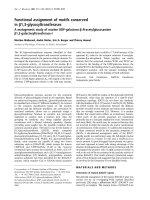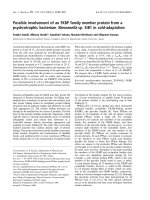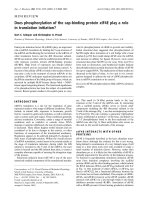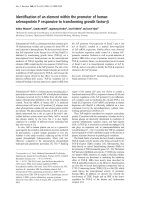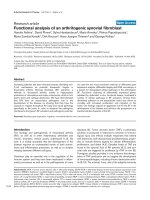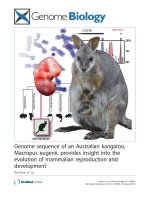Báo cáo y học: " Possible implications of an accessory abductor digiti minimi muscle: a case repor" docx
Bạn đang xem bản rút gọn của tài liệu. Xem và tải ngay bản đầy đủ của tài liệu tại đây (304.88 KB, 4 trang )
BioMed Central
Page 1 of 4
(page number not for citation purposes)
Journal of Brachial Plexus and
Peripheral Nerve Injury
Open Access
Case report
Possible implications of an accessory abductor digiti minimi muscle:
a case report
Luis Ernesto Ballesteros*
1
and Luis Miguel Ramirez*
2
Address:
1
Basic Science Department, Medicine Faculty, Universidad Industrial de Santander, Bucaramanga, Colombia and
2
Department of Basic
Science, Medicine Faculty, Universidad Industrial de Santander, Bucaramanga, Colombia
Email: Luis Ernesto Ballesteros* - ; Luis Miguel Ramirez* -
* Corresponding authors
Abstract
Background: Accessory ADM was first reported in 1868 although muscular, vascular and nervous
variations of the hypothenar eminence are rare, contrary to anomalous muscles in the wrist which
are relatively common.
Case presentation: This case report presents a bilateral variation of an accessory abductor digiti
minimi muscle in a male specimen. Ulnar artery and ulnar nerves were taken into account regarding
their position and trajectory related to this variation.
Conclusion: Muscle size may be an important factor in considering whether a variation is able to
produce neurovascular compression and clinical implications.
Background
This case report presents an abductor digiti minimi
(ADM) muscle's bilateral accessory head, involving ulnar
artery (UA) and ulnar nerve (UN) trajectories' sensorial
and motor components. Although muscular, vascular and
nervous variations of the hypothenar eminence are rare
(differing from anomalous muscles in the wrist), they
have been reported [1-10]. According to Sheppard, three
cases of accessory ADM were first reported by Wood in
1868. Most authors call such additional ADM head an
"accessory" component which can be unilaterally or bilat-
erally presented, producing compression in Guyon's
canal. Harvie et al., found an accessory ADM in 41% of
116 volunteers' asymptomatic ultrasound examinations,
greater prevalence being found in male samples and bilat-
eral presentation in 50% of cases for both genders.
The flexor digiti minimi brevis muscle can also be present
in this area; Madhavi et al., have stated that it relates to the
common phylogeny of these muscles from the same mus-
cle mass [11]. Soldado-Carrera et al., found this variation
to be associated with decreased flexor digitorum superfi-
cialis muscle fourth tendon caliper and median nerve
split. Murata [7] found an accessory ADM in 35 hands,
having one (17%), two (80%) and three fascicles (3%).
Furthermore, Wulle [8] presented eleven cases of acces-
sory ADM, but having "longus" presentation.
Case presentation
This case report arises from one cadaver specimen
amongst a sample of thirty which were obtained from
Universidad Industrial de Santander's Medical Faculty's
Anatomy Department (dissection laboratory) during
2006 academic semesters. The specimen was fixed in 10%
formaldehyde solution. Dissections were performed by
Published: 3 December 2007
Journal of Brachial Plexus and Peripheral Nerve Injury 2007, 2:22 doi:10.1186/1749-7221-2-
22
Received: 24 July 2007
Accepted: 3 December 2007
This article is available from: />© 2007 Ballesteros and Ramirez; licensee BioMed Central Ltd.
This is an Open Access article distributed under the terms of the Creative Commons Attribution License ( />),
which permits unrestricted use, distribution, and reproduction in any medium, provided the original work is properly cited.
Journal of Brachial Plexus and Peripheral Nerve Injury 2007, 2:22 />Page 2 of 4
(page number not for citation purposes)
the authors, involving the antebrachial and hand dorsal
and ventral area. The hypothenar area was carefully dis-
sected following vascular and nervous structures neigh-
bouring the ADM's accessory head. These findings were
recorded and photographed (digital camera and an elec-
tronic Mitutoyo calliper) according to UN side and collat-
eral origin, UA vascular distribution and muscular
variation. The left hand (Figure 1) presented an accessory
ADM head originating in antebrachial fascia and palmaris
longus tendon. According to Murata et al., [7] classifica-
tion resembles "variation 2", however without additional
palmaris longus tendon origin. It passed obliquely
through Guyon's canal, enclosing the UN and vessels. The
accessory head had a late union in its distal trajectory to
form a single pennate with the ADM originating in pisi-
form bone. It was localized over the flexor digiti minimi
brevis muscle and lateral to opponens digiti minimi mus-
cle. Left variation length was 50.6 mm, 11.65 mm wide
and 2.43 mm thick compared to the ADM ipsilateral usual
head which was 55.9 mm, 13.03 mm wide and 7.09 mm
thick. This left accessory ADM head had 34.3% of the
thickness of a usual ADM head. UN and UA were covered
by this ADM accessory head. Sensorial UN branches had
both superficial and deep trajectories regarding muscular
variation and were presented in relation to their trajectory
as superficial sensory branch trajectory coming from the
ulnar nerve's dorsal cutaneous branch and a deep sensory
branch trajectory coming from the ulnar trunk. These
abnormal ulnar nerve branches fitted Kaplan's variation
type 4 according to Hankins et al. [12]. Kaplan's accessory
branch (considered a rare anatomic variant) together with
accessory ADM in the same case have never been reported
in the literature. They were connected after coursing the
accessory ADM head. A third sensorial trajectory course
was observed toward the fourth finger after passing
Guyon's canal as the "fourth common digital nerve". The
right hand (Figure 2) also presented an accessory ADM
head originating in the flexor retinaculum and palmaris
longus tendon. According to Murata et al., [7] classifica-
tion resembles "variation 1" however without additional
palmaris longus tendon origin. It also passed obliquely
through Guyon's canal, enclosing the UN. This accessory
head also had a late union in its distal trajectory to form a
single pennate with the ADM originating in pisiform
bone. It was also localized over the flexor digiti minimi
brevis muscle and lateral to opponens digiti minimi mus-
cle. Right hand variation length was 37.64 mm, 8.59 mm
wide and 3.71 mm thick compared to the usual ipsilateral
ADM head which was 57.7 mm, 13.1 mm wide and 6.92
mm thick. This accessory ADM head had 45.8% of the
thickness of a usual ADM head. The UA adopted a super-
ficial course above the accessory ADM head while the UN
and all its sensorial branches were covered by this varia-
tion. According to UN arborisation patterns by Murata et
al., [7] it looked like a "type 4" classification. These acces-
sory ADM heads received deep UN branch motor innerva-
tions on both sides.
This class of muscular variation entrapping neuro-vascu-
lar bundles may have sensorial and/or muscular implica-
tions in a range of compression neuropathies [5,6].
Entrapment neuropathies can produce heterotopic pro-
jected pain, symptomatic consequences arising from
mechanical nerve injury passing through a narrow ana-
tomical space or under a muscular structure which may
Right-hand hypothenar zoneFigure 2
Right-hand hypothenar zone. ADM: abductor digiti minimi
muscle. AH: accessory head of abductor digiti minimi muscle.
UA: ulnar artery. FR: flexor retinaculum. AF: antebrachial fas-
cia. Asterisk (*): pisiform bone. 1, 2: ulnar nerve sensorial
digital branches. 0: ulnar nerve.
Left-hand hypothenar areaFigure 1
Left-hand hypothenar area. ADM: abductor digiti minimi
muscle. AH: accessory head of abductor digiti minimi muscle.
UA: ulnar artery. UN: ulnar nerve. AF: antebrachial fascia.
PLT: palmaris longus tendon muscle. Asterisk (*): pisiform
bone. 1: Dorsal cutaneous branch of ulnar nerve. 2: UN deep
sensory branch trajectory. 3: Fourth common digital nerve.
Journal of Brachial Plexus and Peripheral Nerve Injury 2007, 2:22 />Page 3 of 4
(page number not for citation purposes)
potentially compress the neuro-vascular package [13-15].
We think that muscle size, tightness and course may be
important factors in considering whether such variations
are able to produce compression.
This scenario can cause nerve oedema and ischemia by
muscle structure friction over the peryneuro which can
cause neuritis and raise endoneural pressure. Involvement
of vegetative contributions must be taken into account
when assessing the effects of such sensorial injuries, due
to their ability to produce complex pain syndromes
[16,17]. In addition to traumatic neuropathic pain, symp-
toms in distal nerve distribution (dysesthesia, paresthesia
and anaesthesia), paresis, hyporeflex, hypotonicity and
atrophy, such as inferior motor neuron lesion, may be
equally feasible [18,19]. The deep UN motor branch may
be compressed by this ADM accessory head and compro-
mise palmar and dorsal interosseous muscles, hypothenar
eminence muscles, lumbricals III and IV and hallux
adductor, thereby producing a clinical "claw hand"
appearance or resembling Guyon's canal syndrome.
Having dealt with this variation's possible sensorial and
motor effects, vascular effects must also be considered. UA
compression (left hand) may produce peripheral vascular
disease from two possible events depending on the type of
compression (i.e. constant or intermittent muscular com-
pression). Muscular hyperfunction can reduce these arte-
rial branches' distal irrigation, causing hypoesthesia or
hyperesthesia in the hand. Likewise, muscular spasm can
produce anaerobic metabolism and consequent nerve irri-
tation by anoxic acidified setting with neurogenic inflam-
mation and peripheral hyperalgesia [20,21]. Permanent
loss of vascular supply during muscular spasm can lead to
vascular claudication and pain [22,23].
We believe (from a functional perspective) that precipitat-
ing factors (gender, occupation, side dominance, trau-
matic history, anatomical characteristics) may develop
neurovascular compression and symptoms in an anoma-
lous muscle; we thus present this anatomical case. The
morphological characteristics led to all the above
explained symptomatic possibilities; however, lacking
clinical judgment, further statements lose their functional
value and become merely speculative.
Conclusion
Muscular variations compromising neurovascular bun-
dles may produce clinical symptoms such as dysaesthesic
pain, sensory loss, wakefulness and paresis, highlighting
these anatomical discrepancies' importance when they are
presented. However, the existence of an accessory ADM is
usually asymptomatic and only rarely results in nerve
compression. It does appear that muscle size, tightness
and course may be an important factor in considering
whether such variation is able to produce UN compres-
sion at Guyon's canal or UA compression resulting in a
poor relationship between blood-flow and artery diame-
ter. A larger sample of cadaver specimens is needed. Also,
further clinical studies are required to confirm the exist-
ence of these variations' clinical effects.
List of abbreviations
Abductor digiti minimi muscle – ADM
Ulnar nerve – UN
Ulnar artery – UA
Authors' contributions
Luis Ernesto Ballesteros Acuña – ES, FG
Luis Miguel Ramirez Aristeguieta – ES, FG
Acknowledgements
We thank Javier Ariza Alvares (MD) for his contribution in acquiring data.
References
1. Curry B, Kuz J: A new variation of abductor digiti minimi
accessorius. J Hand Surg 2000, 25:585-7.
2. Soldado-Carrera F, Vilar-Coromina N, Rodriguez-Baeza A: An
accessory belly of the abductor digiti minimi muscle: a case
report and embryologic aspects. Surg Radiol Anat 2000, 22:51-4.
3. Kanaya K, Wada T, Isogai S, Murakami G, Ishii S: Variation in inser-
tion of the abductor digiti minimi: an anatomic study. J Hand
Surg 2002, 27(2):325-8.
4. Bozkurt MC, Tagil SM, Ersoy M, Tekdemir I: Muscle variations and
abnormal branching and course of the ulnar nerve in the
forearm and hand. Clin Anat 2004, 17:64-6.
5. Sheppard JE, Prebble TB, Rahn K: Ulnar neuropathy caused by an
accessory abductor digiti minimi muscle. Wis Med J 1991,
90:628-31.
6. Netscher D, Cohen V: Ulnar nerve compression at the wrist
secondary to anomalous muscles: a patient with a variant of
abductor digiti minimi. Ann Plast Surg 1997, 39:647-51.
7. Murata K, Tamai M, Gupta A: Anatomic study of variations of
hypothenar muscles and arborization patterns of the ulnar
nerve in the hand. J Hand Surg 2004, 29:500-9.
8. Wulle CM: abductor digiti minimi longus: anatomical rarity?
Handchir Mikrochir Plast Chir 1987, 19:43-5.
9. Harvie P, Patel N, Ostlere SJ: Ulnar nerve compression at
Guyon's canal by an anomalous abductor digiti minimi mus-
cle: the role of ultrasound in clinical diagnosis. Hand Surg 2003,
8:271-5.
10. Harvie P, Patel N, Ostlere SJ: Prevalence and epidemiological
variation of anomalous muscles at Guyon's canal. J Hand Surg
2004, 29:26-9.
11. Madhavi C, Holla SJ: Anomalous flexor digiti minimi brevis in
Guyon's canal. Clin Anat 2003, 16:340-3.
12. Hankins CL, Flemming S: A variant of Kaplan's accessory branch
of the dorsal cutaneous branch of the ulnar nerve: a case
report and review of the literature. J Hand Surg 2005,
30:1231-5.
13. Dworkin RH, Backonja M, Rowbotham MC, Allen RR, Argoff CR,
Bennett GJ, Bushnell MC, Farrar JT, Galer BS, Haythornthwaite JA,
Hewitt DJ, Loeser JD, Max MB, Saltarelli M, Schmader KE, Stein C,
Thompson D, Turk DC, Wallace MS, Watkins LR, Weinstein SM:
Advances in neuropathic pain: diagnosis, mechanisms, and
treatment recommendations. Arch Neurol 2003, 60:1524-34.
14. Castaldo JE, Ochoa JL: Mechanical injury of peripheral nerves:
fine structure and dysfunction. Clin Plast Surg 1984, 11:9-16.
Publish with BioMed Central and every
scientist can read your work free of charge
"BioMed Central will be the most significant development for
disseminating the results of biomedical research in our lifetime."
Sir Paul Nurse, Cancer Research UK
Your research papers will be:
available free of charge to the entire biomedical community
peer reviewed and published immediately upon acceptance
cited in PubMed and archived on PubMed Central
yours — you keep the copyright
Submit your manuscript here:
/>BioMedcentral
Journal of Brachial Plexus and Peripheral Nerve Injury 2007, 2:22 />Page 4 of 4
(page number not for citation purposes)
15. Ginanneschi F, Dominici F, Milani P, Biasella A, Rossi A: Evidence of
altered motor axon properties of the ulnar nerve in carpal
tunnel syndrome. Clin Neurophysiol 2007, 118:1569-76.
16. Hoffman KD, Matthews MA: Comparison of sympathetic neu-
rons in orofacial and upper-extremity nerves: implications
for causalgia. J Oral Maxillof Surg 1990, 48:720-6.
17. Tracey DJ, Cunningham JE, Romm MA: Peripheral hyperalgesia in
experimental neuropathy : mediation by a2-adrenorecep-
tors on post-ganglionic sympathetic terminals. Pain 1995,
60:317-27.
18. Gordon L, Ritland GD: Nerve entrapment syndromes. Conn Med
1974, 38:97-102.
19. Sarno JB: Suprascapular nerve entrapment. Surg Neurol 1983,
20:493-97.
20. Basbaum AI: Distinct neurochemical features of acute and per-
sistent pain. Proc Natl Acad Sci 1999, 96:7739-43.
21. Simone DA, Ochoa J: Early and late effects of prolonged topical
capsaicin on cutaneous sensibility and neurogenic vasodilata-
tion in humans. Pain 1991, 47:285-94.
22. Nawaz S, Walker RD, Wilkinson CH, Saxton JM, Pockley AG, Wood
RF: The inflammatory response to upper and lower limb
exercise and the effects of exercise training in patients with
claudication. J Vasc Surg 2001, 33:392-9.
23. Pritchard MH, Pugh N, Wright I, Brownlee M: A vascular basis for
repetitive strain injury. Rheumatology (Oxford) 1999, 38:636-9.
